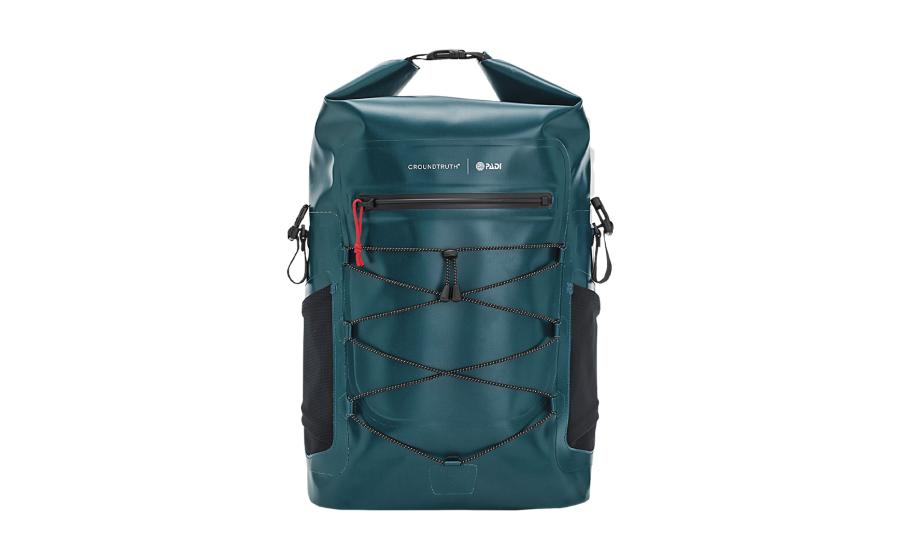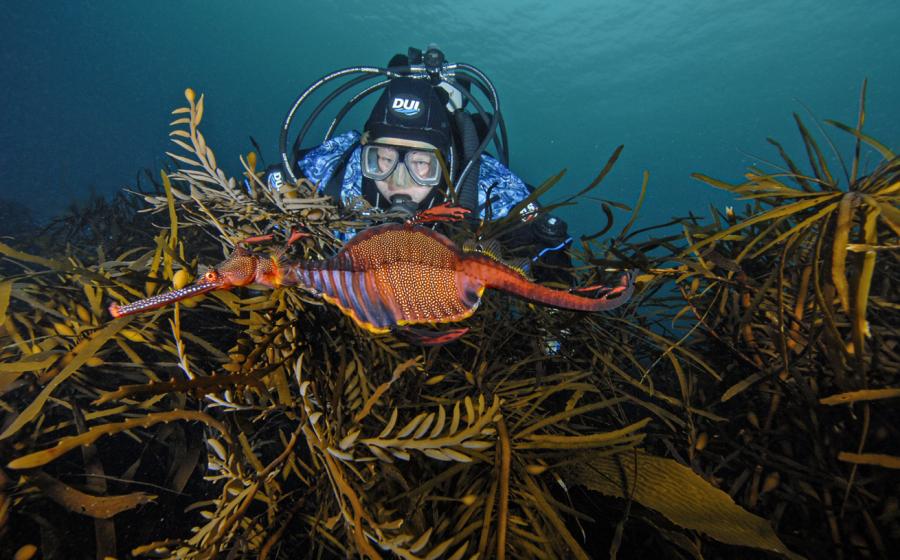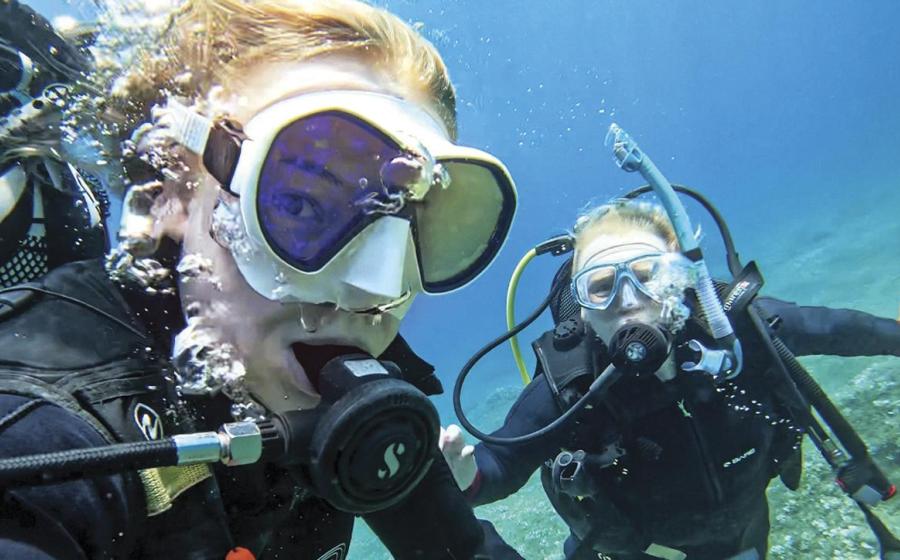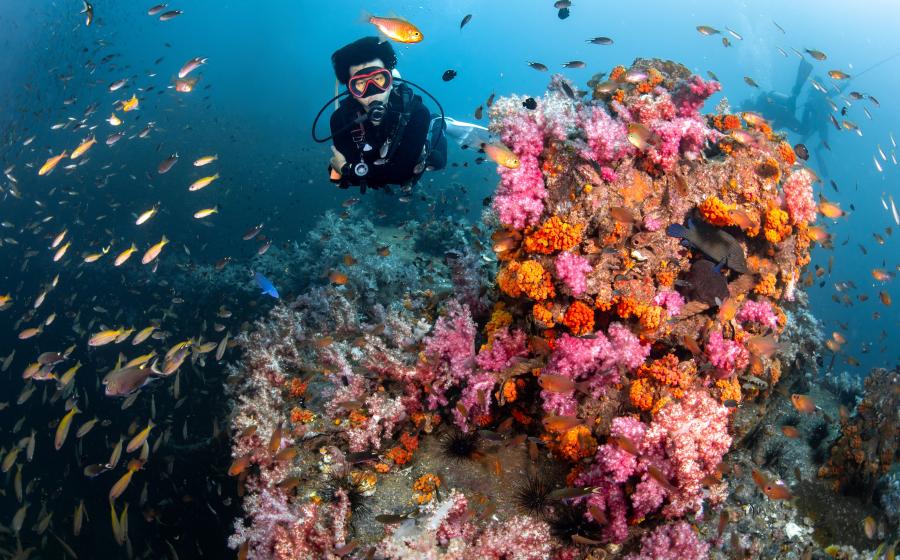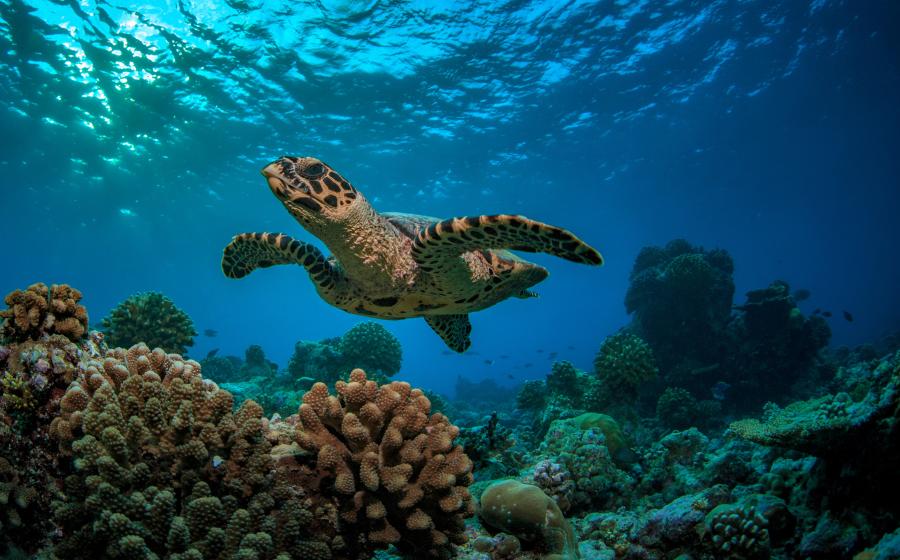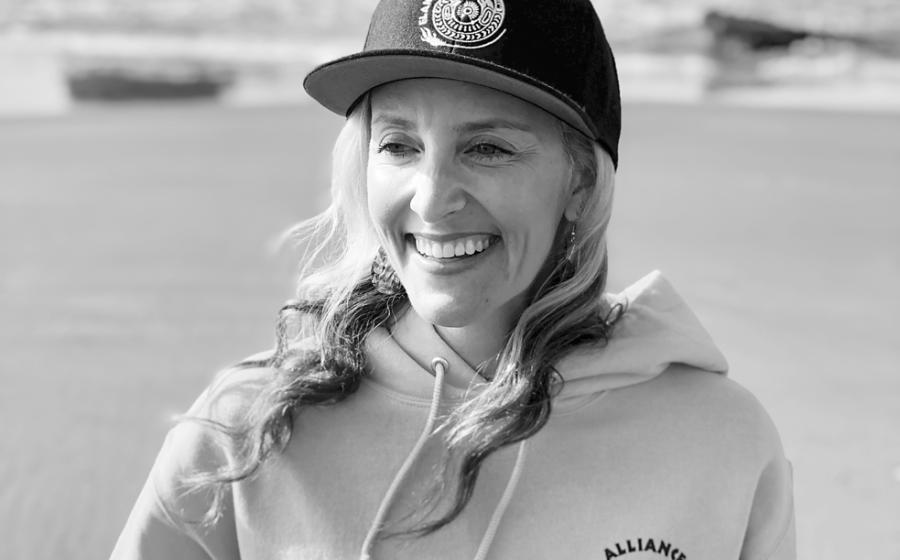Best Destinations for Wall Diving

Brandon ColeA vibrant red erect rope sponge is nestled between two sprawling deep-water sea fans just off the island of Grand Cayman.
Grand Cayman
The three Cayman Islands lay claim to more than 150 wall dives, all with visibility of 100 feet or greater and each within 15 minutes of the coast by boat. With walls so close, divers can add more to the schedule, whether that’s exploring the island or packing in more diving.
Grand Cayman’s East End serves up 27 unique wall dives, offering a mix from canyons to pinnacles.
Most of all, it’s the sheerness that wows. At Breakers Cutback on the southeast coast, the drop is so sheer that it has negative incline.
“The wall arches over your head like a wave,” says Stephen Broadbelt, owner of Ocean Frontiers dive center, located on the East End.
The slope of some stretches, coupled with the visibility, can be dizzying.
“You don’t get the full sense of the visibility until you look down,” says Broadbelt. “You see thousands of feet below and the verticality feels infinite.”
The farther down a diver drops, the less the water is affected by wave action, and thus appears even clearer.
“You get the sense that you’re flying off a mountain like an eagle."
The verticality impresses differently at Turtle Pass on the north coast, offering that picture-perfect, straight-up-and-down verticality.
Every wall dive offers something slightly different. Take those with less of a dramatic incline. Barrel sponges can’t set down roots on walls that are too vertical, needing this gentler slope to thrive.
Sites like the Maze are cut with narrow canyons zigzagging through. At Three Sisters, sheerness comes in the form of three pinnacles packed with marine life.
“We’ve got wall after wall,” says Broadbelt. “You could say we have wall-to-wall walls.”
Need To Know
When To Go Year-round
Visibility 100 to 130 feet
Water Temps 79 to 82 degrees
What To Bring Dialed-in buoyancy. Take the PADI Peak Performance Buoyancy course to ensure confidence at depth.
Contact Ocean Frontiers (oceanfrontiers.com)
Related Reading: Insider’s Secret: Where the Locals Dive in the Cayman Islands
British Columbia

Brandon ColeThe walls in British Columbia are packed with marine life such as glove sponges, raspberry soft corals, plumose anemones and sea urchins, among others.
The subarctic current sweeps north along the coast of British Columbia, carrying masses of nutrients that create an ultra-rich marine environment. The best evidence of this can be found at wall dives such as Browning Pass, one of the region’s best, renowned for color galore.
“You can’t put a finger down without touching something alive,” says Tiare Boyes, who manages social media for God’s Pocket Resort, a private island hideaway with dive boats.
Boyes isn’t advocating poking the living matter but rather points out that this wall site is packed with invertebrates, starting with giant acorn barnacles.
“Once they die, they create apartment buildings for crabs, nudibranchs and giant sculpin,” she says.
In between it all, divers find the colors that this cold-water region is so famous for: brilliant sulfur boring sponges, red soft corals and purple coralline algae.
It pays to go slow—much of the life here has adapted to blend in.
Of course, for some divers, the biggest thrills come from the biggest animals.
The rockfish can grow to more than 3 feet long, and even the Pacific octopus can be found in bigger sizes. It’s these two that divers are most keen to see.
“They are really the showstoppers.”
Need To Know
Whe To Go God’s Pocket Resort has two distinct dive seasons: March until late May/early June, and again from late August through mid-October. In between, the resort is open for kayaking guests.
Visibility 70 to 80 feet
Water Temps 45 to 46 degrees
What To Bring A good dive light to fully appreciate the rich colors of the marine life at depth.
Contact God’s Pocket Resort (godspocket.com)
Palau

Mark B. HatterA large sea fan beckons divers to plunge deeper and experience the diverse marine life that resides on and around Palau’s walls.
Two converging currents, the Pacific Ocean and the Philippine Sea, meet at Peleliu, arguably the most famous wall dive in the island nation of Palau, found in the western central Pacific Ocean. This site juts into deep water, intersecting major marine life thoroughfares.
There, divers might encounter anything from a dozen gray reef sharks to massive schools of trevallies.
“The amount of life is just explosive,” says Udi Bornovski, owner of Fish ‘N Fins dive center, a PADI Five Star IDC.
It’s the sort of place where the unexpected is quite common, where a hammerhead, bull shark, manta and even a sailfish might ride alongside divers.
“You have the possibility of seeing just about anything because it’s so out there,” says Bornovski. “Even on what you might call a ‘miss’ day, it’s still a great dive.”
Second on the list of most requested dives in Palau is Blue Corner, which starts with a show at the edge of the wall. Divers rely on reef hooks to stay static amid strong currents where sharks swoop in to hunt. The dive continues down canyons packed tight with lettuce corals and giant clams. This isn’t a place to get too comfortable with a narrow focus, however. Look up to spot the occasional manta or Napoleon wrasse. The site is so dense with life that guests tend to want to dive it again and again in the same week.
“Rarely do you have a site that guests want to repeat,” says Bornovski, but with Blue Corner, once isn’t enough.
Need To Know
When To Go Year-round
Visibility 75 to 150 feet
Water Temps 81 to 86 degrees
What To Bring Fins stiff or long enough to provide power in a current.
Contact Fish ‘N Fins (fishnfins.com)
Related Reading: Palau's Enduring Dive Appeal
Readers Choice Awards 2024
This year we surveyed 13,322 readers on their favorite destinations, resorts, operators and liveaboards, awarding their top picks across a variety of categories. Our Readers Choice travel feature highlights the first-place destinations in each global region and offers a taste of what makes each a reader favorite.





